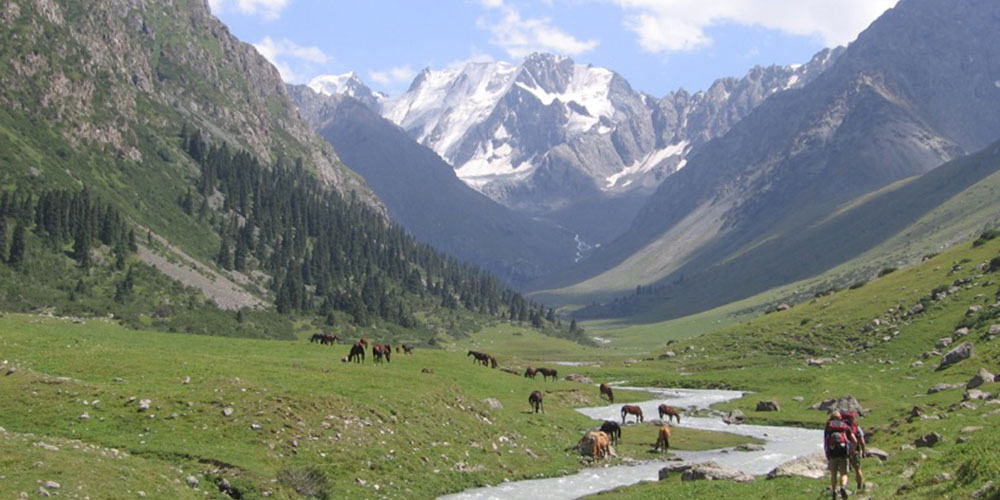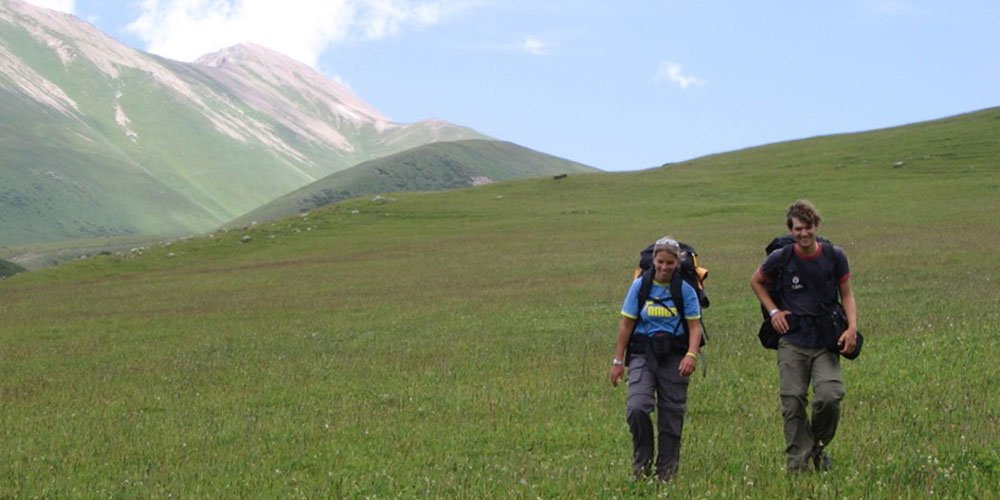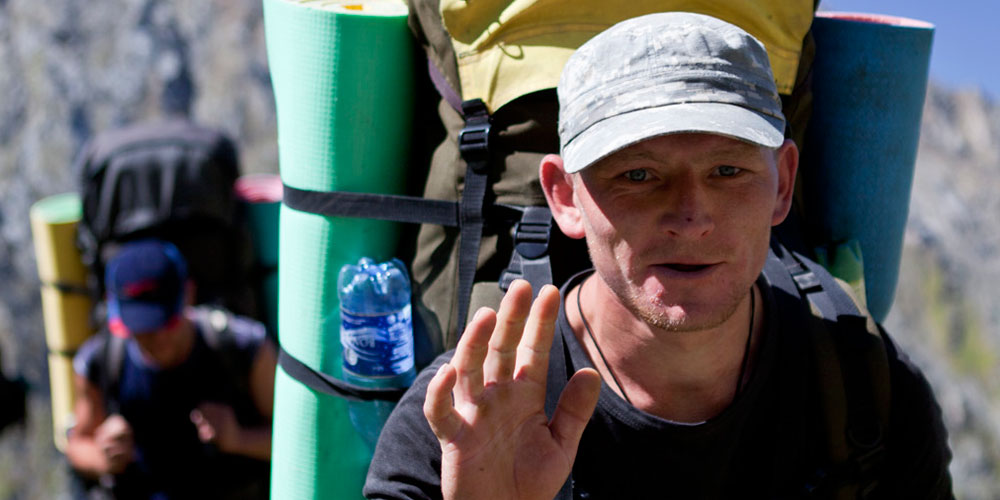| Pamir mountains |
The Pamirs are one of the highest mountain ranges in the world, it lie at the junction of three great ranges, the Hindu Kush, Tien Shan and the Karakorum, and constitute a huge land mass over 3,700m. The Tadjiks call this region Bom-i-Dunyo, the Roof of the World, although some claim that Pamir means "feet of the sun". This mountainous area, a large part of which is located in Tajikistan, is one of the most inaccessible areas in the world. A former British Ambassador to Tajikistan described the fascination and beauty of the region as "one of the world's best kept secrets".
Presently Pamir occupies almost half of modern Tajikistan and very south regions of Kyrgyzstan.
Three of the highest peaks in the former Soviet Union lie here, Peak Communism, Peak Korjenevskoi and Peak Lenin. There are more than 50 mountains over 6,000 metres many of which are still unclimbed and could be ideal expedition objectives.
The highest at 7,495m is Peak Communism, which has been re-named Peak Somoni after the powerful 12th century Tajik Samanid dynasty. Further to the north, in the Academi Nauk Range, and facing Peak Communism on the other side of Moskvin Glade is the other mighty giant of the Pamirs, Peak Evgenia Korjenevskaya (7,105 m). These two giants overlook a large moraine, Moskvin Glade at 4200 m, with a fine lake and a spectacular view of the surrounding mountains. The glade is encircled by three glaciers, Walter, Traube and Moskvina, named after 3 topographers first reached the area and used as the starting point to both summits. Ice-climbing enthusiasts will find good seracs there, for practice.
Lenin peak (7134m) is the second highest peak of the Pamirs located in the south region of Kyrgyzstan in the area called Pamir-Alai. The area 80 km East of Lenin Peak is also interesting as there are massifs of Korumdy and Zarya Vostoka (Eastern Sunrise) peaks with a chain of virgin summits.
Though the highest peaks have been climbed for many years there are many mountains in the Pamirs which are yet unconquered. There is endless scope for exploratory climbing and many as-yet-unclimbed summits beckon the experienced mountaineer in search of a fresh challenge.
Fantastic Asia Travel Company Limited can assist with logistical arrangements for groups who are interested in climbing Peak Communism, Peak Korjenevskaya or Peak Lenin. We are also arrange the exploratory climbing expeditions to the eastern Pamirs with the opportunity to attempt a virgin summits. Please contact us if you are interested in being kept informed of developments.
When to go
Generalisations about seasonal climatic variation in the Pamirs are difficult; elevations increase dramatically from west to east and thus while the middle of the summer is the best season on the high-altitude Murghab plateau (3,800 m) in the east, the trekker is liable to be plagued by high humidity, hazy skies and raging flood waters in the sub-tropical valleys of Darwaz (1,200 m) in the west. Similarly, variations in precipitation dictate that around the Peak Communism massif in the central Pamirs, the glacier line is at around 2,800 m, while on the arid wind-swept Murghab plateau it is at around 5,000 m.
However, the most comfortable season for trekking in the Pamirs is July-September. Deep snow prevents the crossing of even the lowest mountain passes until late June, while after September serious winter equipment is needed and the Tajik and Kyrgyz shepherds, a glimpse into whose rugged lives is one of the highlights of any trip, have started to retreat from the high pastures. In these summer months, diurnal temperature ranges can be dramatic with daytime temperatures of over 30 degrees, and frost registered every night above 4,000 m. The mountains, always barren beyond the irrigated fields of the villages, can appear at their most desolate; yet in the upper valleys, beyond the final village and road-head, you will come across dazzling Alpine pastures, small niches for wild flowers, bees and butterflies. It is to these pastures that the shepherds head with their flocks of sheep and goats and herds of cattle and yak, the shepherds' camps comprising dry-stone aylaqs in the case of the Tajiks, yurts in the case of the Kyrgyz (in Murghab region).
Beyond the final shepherds you will soon be into glacial moonscapes, where the river crossings are treacherous, and eventually the glaciers themselves. At this time of the year you can readily cross the high passes, most of which lie from 4,600 to 5,000 m, from one major valley to the next.
Autumn, running from late September to late November, affords the most picturesque landscapes as the skies are clearer, the rivers are running lower and turquoise blue, while the fields and orchards of the villages are a blaze of colour and harvest activity. Lower night-time temperatures must be contended with and the shepherds are leaving, but on the other hand the high passes are even freer of snow. Lower altitude trekking, village to village, is truly sublime at this time of year.
The first of the heavy snow fall usually hits Khorog in late December, but the higher villages in all the river valleys will be under snow one month before then. While the winter-wonderland scenery is truly majestic, winter trekking in the Pamirs is a serious business, with all but the lowest passes impossible. In 2001, Bulumkul meteorological station in Murghab region recorded minus 58 degrees, and if you are not adequately prepared you can expect frostbite. High-altitude sunshine is fierce, and the winds correspondingly so. Running water is hard to come by and you will need a stove not only for cooking food but also for melting snow. Perhaps the greatest impediment is not the cold temperatures, which can be mitigated, but the shortness of the days and the corresponding long nights. You will need to be in your 4-season sleeping bag from when the sun goes down at 17h00 to when it hits your tent at 09h00, and after several nights of this you will be all-too-familiar with the personal habits and histories of your companions.
Spring, running from late March to June, is the least rewarding time for high-altitude trekking in the Pamirs. High valleys and passes are still clogged with snow, the mountains are frequently cloud covered, and the risk of avalanches and rockfalls is at its highest. Trekking at lower altitudes is enhanced as the village fruit orchards are in full blossom and the winter wheat is emerald green in the fields.
Maps
Maps adequate for trekking in Tadjik Pamir cannot be found in Tajikistan, as for Trekking in Kyrgyz part maps are available. Far and away the best maps (for both areas) are the Soviet "military" maps (1:100,000 and 1:200,000), available from travel agency. They give a good overview of details, although they contains place names and show the contours - but it requires knowledge of Cyrillic characters. Actually, they do not carry any secret information but if you have any of these maps, be sure to keep them away from the prying eyes of the Russian Border Forces or "KGB" in Tadjikistan who will be happy to relieve you of them.
Guides
The concept of porters is unknown in the Tajik Pamirs, though you can hire donkeys and horses in the villages and shepherds' camps. These are not cheap and you will be asked for $20 per animal per day, plus something for the donkey-man / horseman. As the animals are required in the daily lives of the local Tajiks it is sometimes difficult to obtain them at short notice - it is best to book them well in advance. People will be bemused if you ask for a guide, but will enthusiastically point the way. Every villager has tales of friends and relatives crossing the passes - to find someone who has actually done it is a far different proposition. While it is certainly the case that most of the passes provided routeways in former generations, the construction of roads in Soviet times, linking the valleys at their lower ends, meant the abandonment of such routes, and the loss of knowledge of their passage. Occasional tumbledown cairns on passes indicate that someone came through here once upon a time, but for the most part you will feel like you are the first.
A note on hospitality
Pamir hospitality is legendary, and you will undoubtedly meet with it along the way, whether in villages or shepherds' camps. Interaction with local communities is always one of the most rewarding and memorable experiences of a visit to any foreign culture, and you will doubtless be entertained by raw musical performances in the museums that are Pamir houses or Kyrgyz yurts. However, it is easy for such hospitality, especially in the economic conditions of Tajikistan, to be abused. You will be offered the same food to eat as that eaten by the poverty-stricken people of the settlements in which you are staying - that means bread, salt-tea, dairy products, meat which unless freshly slaughtered is likely to be somewhat dubious, and, either fresh or dried fruits (apricots, mulberry). If you accept the hospitality, you will be obliged to eat the food. If you produce your own food, you should be prepared to share it around, and it won't go very far in a household of over 10 people. If you are more than 2 people it is in any case unfair to accept the hospitality of food-deficit families. Gifts, preferably cash, will be refused at first but accepted eventually, and you should persevere. The amount is up to you, you soon learn to gauge it, but it would be suggested $5 per night. If you supplement this by taking photographs of the family, and honouring your promise to forward the prints, the host family will be delighted. Remember that you may not be near a settlement at night. Furthermore, the limited space and means of shepherds' camps, and the eye-stinging smoke of the aylaq, may mean you have to (or prefer) to sleep outside anyway.
Permissions
Planning the trip to Tadjik Pamirs the one will need a letter of invitation which will allow you to acquire a Tadjik visa on arrival at Dushanbe airport or Tadjik embassy. Once in Dushanbe, you will need to get your visa validated with a separate permission for Gorno-Badakhshan area(propusk) at the Ministry of Foreign Affairs. Be aware that it can take ten days or three if you inform the travel agency in advance.
If you wish to trek to Lake Sarez, you will need yet another permission, this time from the Ministry of Civil Defence and Emergency Situations. Here you need to submit a letter at least ten days in advance to the Minister himself. Once you have submitted your letter, you would be advised to contact authorized person at the Ministry, who ultimately issues the propusks; expect the propusk to take at least one full day to issue. Without the propusk you will not be allowed to proceed beyond Barchidev, the last village before the lake on the approach from the Bartang Valley. Documents are checked in Barchidev village, and, for those trekking in from Murghab and Shugnan regions, at Zaval dam at the downstream end of the dam.
Travelling in Kyrgyz Pamirs you will need a Kyrgyz visa (see Visa and formalities section) and border zone access permission. Visas can be obtained from Kyrgyz Embassies or consulates where they exist or where Kyrgyzstan has no diplomatic representation in Kazakhstan or Russian Federation embassy. You also can pick up visa at the international arrivals lounge at Bishkek Manas international airport. Border zone access permit can be obtained from travel agency. Be aware that it can take some time.
Trekking and climbing suggestions
Trekking and climbing in the Pamirs is about as difficult as it gets. You need to be well-equipped and fully independent in terms of supplies. The terrain is tough, and there are no tea-shops or lodges along the way. Once you are above the shepherds' camps you are on your own, and paths are often non-existent. Note the permissions required, as described above. On the other hand, all the treks outlined in the links below offer stunning scenery, are highly enjoyable and manageable with a minimum of technical equipment and expertise. They have been graded 1-5 in terms of physical (non-technical) difficulty.
It is strongly recommended to trek in Pamirs only on organized tour or being accompanied by local guide.
If you are interested in some of the treks or jeep tours in Tajikistan
please contact us for futher details.
Remember that some areas should be avoided unless you are on organized
tour with a local guide who knows the area.












